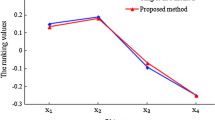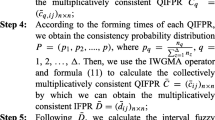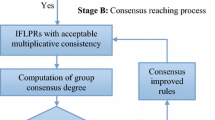Abstract
This paper aims to offer an intuitionistic triangular fuzzy group decision making method by preference relations. For this purpose, the concept of intuitionistic triangular fuzzy preference relations (ITFPRs) is first offered. Then, an additive consistency concept for ITFPRs is introduced. Meanwhile, a programming model is built to check the consistency of ITFPRs. Considering the case where incomplete ITFPRs are obtained, two programming models are constructed, which aim at maximizing the consistency and minimizing the uncertainty of missing information. To achieve the goals of the minimum total adjustment and the smallest number of adjusted elements, two programming models are established to repair inconsistent ITFPRs. In addition, the weights of decision makers are considered, and the consensus levels of individual ITFPRs are studied to ensure the representativeness of decision results. When individual ITFPRs do not meet the consensus requirement, a programming model to reach the consensus threshold is constructed, which permits different intuitionistic triangular fuzzy variables (ITFVs) to have different adjustments and minimizes the total adjustment. Finally, a group decision making algorithm with ITFPRs is proposed, and its feasibility and efficiency are demonstrated through an example of evaluating the intelligent traditional Chinese medicine decocting centers.
Similar content being viewed by others
References
Saaty TL (1980) The analytic hierarchy process. McGraw-Hill, New York
Saaty TL, Vargas LG (1987) Uncertainty and rank order in the analytic hierarchy process. Eur J Oper Res 32:107–117
Xu ZS (2001) A practical method for priority of interval number complementary judgement matrix. Oper Res Manag Sci 10(1):16–19
Tapia García JM, del Moral MJ, Martínez MA, Herrera-Viedma E (2012) A consensus model for group decision making problems with linguistic interval fuzzy preference relations. Expert Syst Appl 39:10022–10030
Meng FY, An QX, Chen XH (2016) A consistency and consensus-based method to group decision making with interval linguistic preference relations. J Oper Res Soc 67:1419–1437
Xu ZS (2007) Intuitionistic preference relations and their application in group decision making. Inf Sci 177:2363–2379
Xu ZS (2007) Intuitionistic fuzzy aggregation operators. IEEE Trans Fuzzy Syst 15:1179–1187
Xu ZS, Chen J (2007) On geometric aggregation over interval-valued intuitionistic fuzzy information. In: 4th International Conference on Fuzzy Systems and Knowledge Discovery (FSKD): 466–471
Liu F, Yuan XH (2007) Fuzzy number intuitionistic fuzzy set. Fuzzy Syst Math 21(1):88–91
Wang XF (2008) Fuzzy number intuitionistic fuzzy arithmetic aggregation operators. Int J Fuzzy Syst 10(2):104–111
Wei GW, Zhao XF, Lin R (2010) Some induced aggregating operators with fuzzy number intuitionistic fuzzy information and their applications to group decision making. Int J Comput Intell Syst 3(1):84–95
Zhou SH, Chang WB (2014) Approach to multiple attribute decision making based on the Hamacher operation with fuzzy number intuitionistic fuzzy information and their application. J Intell Fuzzy Syst 27(3):1087–1094
Gao Y, Zhou DQ, Liu CC, Zhang L (2012) Triangular fuzzy number intuitionistic fuzzy aggregation operators and their application base on interaction. Syst Eng Theory Pract 32(9):1964–1972
Xia MM, Xu ZS, Zhu B (2012) Generalized intuitionistic fuzzy Bonferroni means. Int J Intell Syst 27(1):23–47
Verma R (2015) Generalized bonferroni mean operator for fuzzy number intuitionistic fuzzy sets and its application to multiattribute decision making. Int J Intell Syst 30(5):499–519
Yu DJ (2013) Prioritized information fusion method for triangular intuitionistic fuzzy set and its application to teaching quality evaluation. Int J Intell Syst 28(5):411–435
Mahmood T, Liu PD, Ye J, Khan Q (2018) Several hybrid aggregation operators for triangular intuitionistic fuzzy set and their application in multi-criteria decision making. Granul Comput 3(2):153–168
Chen DF, Zhang L, Jian JS (2010) Triangle fuzzy number intuitionistic fuzzy aggregation operators and their application to group decision making. In: international conference on artificial intelligence and computational intelligence (AICI): 350–357
Zhang QL, Liu F, Fan CQ, Xie WH (2018) Fuzzy numbers intuitionistic fuzzy descriptor systems. Inf Sci 469:44–59
Wu D, Yan XB, Peng R, Ma XY (2019) Multi-criteria decision making based on correlation coefficient of triangular intuitionistic fuzzy numbers. J Shanghai Jiao Tong Univ (Sci) 24(4):480–484
Xu J, Dong JY, Wan SP, Yang DY, Zeng YF (2019) A heterogeneous multiattribute group decision-making method based on intuitionistic triangular fuzzy information. Complexity. https://doi.org/10.1155/2019/9846582
Zhao BF, Zhang C, Jia BS, Zhai CX, Ren HZ, Guo JW (2016) Research on application of TIFNs-AHP to safety investment in coal enterprises. China Saf Sci J 26(3):145–150
Zhang Z, Kou XY, Dong QX (2018) Additive consistency analysis and improvement for hesitant fuzzy preference relations. Expert Syst Appl 98:118–128
Xiao J, Wang XL, Zhang HJ (2020) Managing personalized individual semantics and consensus in linguistic distribution large-scale group decision making. Inform Fusion 53:20–34
Yu WY, Zhang Z, Zhong QY (2019) Consensus reaching for MAGDM with multi-granular hesitant fuzzy linguistic term sets: a minimum adjustment-based approach. Ann Oper Res. https://doi.org/10.1007/s10479-019-03432-7
Zhang HJ, Zhao SH, Kou G, Li CC, Dong YC, Herrera F (2020) An overview on feedback mechanisms with minimum adjustment or cost in consensus reaching in group decision making: research paradigms and challenges. Inform Fusion 60:65–79
Dong YC, Zha QB, Zhang HJ, Kou G, Fujita H, Chiclana F, Herrera-viedma E (2018) Consensus reaching in social network group decision making: research paradigms and challenges. Knowl-Based Syst 162:3–13
Capuano N, Chiclana F, Herrera-Viedma E, Fujita H, Loia V (2019) Fuzzy group decision making for influence-aware recommendations. Comput Hum Behav 101:371–379
Zhou XY, Ji FP, Wang LQ, Ma YF, Fujita H (2020) Particle swarm optimization for trust relationship based social network group decision making under a probabilistic linguistic environment. Knowl-Based Syst 200:105999
Wu J, Sun Q, Fujita H, Chiclana F (2019) An attitudinal consensus degree to control feedback mechanism in group decision making with different adjustment cost. Knowl-Based Syst 164:265–273
Capuano N, Chiclana F, Fujita H, Herrera-Viedma E, Loia V (2018) Fuzzy group decision making with incomplete information guided by social influence. IEEE Trans Fuzzy Syst 26(3):1704–1718
Lodwick WA, Jenkins OA (2013) Constrained intervals and interval spaces. Soft Comput 17(8):1393–1402
Krejčí J (2017) On additive consistency of interval and fuzzy reciprocal preference relations. Comput Ind Eng 107:128–140
Xu ZS (2007) A survey of preference relations. Int J Gen Syst 36:179–203
Tang J, Meng FY, Zhang YL (2018) Decision making with interval-valued intuitionistic fuzzy preference relations based on additive consistency analysis. Inf Sci 467:115–134
Zhang SL, Meng FY (2020) Analysis of the consistency and consensus for group decision-making with interval-valued intuitionistic fuzzy preference relations. Comput Appl Math. https://doi.org/10.1007/s40314-020-01177-9
Chiclana F, Mata F, Alonso S, Herrera-Viedma E, Martinez L (2008) Integration of a consistency control module within a consensus decision making model. Int J Uncert Fuzz Knowl-Based Syst 16(Suppl. 01):35–53
Tang J, Meng FY, Zhang SL (2019) Consistency comparison analysis of decision making with intuitionistic fuzzy preference relations. IEEE Trans Eng Manag. https://doi.org/10.1109/TEM.2019.2919559
Meng FY, Chen SM, Zhang SL (2020) Group decision making with heterogeneous intuitionistic fuzzy preference relations. Inf Sci 523:197–219
Zhang Z, Yu WY, Gao Y (2019) Managing multigranular unbalanced hesitant fuzzy linguistic information in multiattribute large-scale group decision making: a linguistic distribution-based approach. IEEE Trans Fuzzy Syst:1. https://doi.org/10.1109/TFUZZ.2019.2949758
Zhang Z, Kou XY, Yu WY, Gao Y (2020) Consistency improvement for fuzzy preference relations with self-confidence: An application in two-sided matching decision making. J Oper Res Soc:1–14. https://doi.org/10.1080/01605682.2020.1748529
Zhang BW, Liang HM, Zhang GQ, Xu YF (2018) Minimum deviation ordinal consensus reaching in GDM with heterogeneous preference structures. Appl Soft Comput 67:658–676
Tang J, Chen SM, Meng FY (2019) Heterogeneous group decision making in the setting of incomplete preference relations. Inf Sci 483:396–418
Zhou XY, Wang LQ, Liao HC, Wang SY, Lev B, Fujita H (2019) A prospect theory-based group decision approach considering consensus for portfolio selection with hesitant fuzzy information. Knowl-Based Syst 168:28–38
Liu X, Xu YJ, Ge Y, Zhang WK, Herrera F (2019) A group decision making approach considering self-confidence behaviors and its application in environmental pollution emergency management. Int J Env Res Pub He 16(3):385
Rao CJ, Lin H, Liu M (2020) Design of comprehensive evaluation index system for P2P credit risk of “three rural” borrowers. Soft Comput 24(15):11493–11509
Liao HC, Si GS, Xu ZS, Fujita H (2018) Hesitant fuzzy linguistic preference utility set and its application in selection of fire rescue plans. Int J Env Res Pub He 15(4):664
Acknowledgements
This work was supported by the National Natural Science Foundation of China (No.71571192), the Innovation-Driven Project of Central South University (No. 2019KF-09), and the Major Project for National Natural Science Foundation of China (No. 71790615).
Author information
Authors and Affiliations
Corresponding author
Additional information
Publisher’s note
Springer Nature remains neutral with regard to jurisdictional claims in published maps and institutional affiliations.
Rights and permissions
About this article
Cite this article
Zhang, S., Meng, F. A group decision making method with intuitionistic triangular fuzzy preference relations and its application. Appl Intell 51, 2556–2573 (2021). https://doi.org/10.1007/s10489-020-01879-x
Published:
Issue Date:
DOI: https://doi.org/10.1007/s10489-020-01879-x




